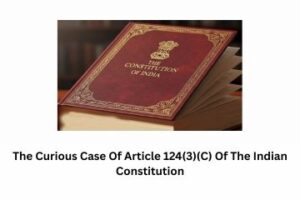Critical Analysis of Crime
Written by: Akarsh Sharma
Crime, a word which cannot be determined is always stated as a negative act done by a person or a group of people worldwide and both crime and criminal are indeed looked upon with the greatest hatred by all sections of the people in society.
During the times of uncivilized society, there was no criminal law, every man was his protector, any person can be attacked at any time and the method of punishment was vengeance. The principle was the survival of the fittest the person attacking was either defeated or was able to achieve the reason of its attack, for relief or compensation the main forerunner of criminal justice was “A tooth for a tooth, an eye for an eye, a life for life”.
With the advancement of time, the method of taking compensation came into existence, the injured party started taking other benefits as a relief rather than killing their adversaries. Subsequently, a sliding scale came into existence for satisfying ordinary offences. Such a system gave birth to archaic criminal law. This method of relief stayed for a long time and the application of this function was in the hand of parties, but gradually this function came into the hands of the state to perform.
After the time of kingship, the concept of crime and its distinction with the civil wrong emerged. Earlier there was no distinction between the law of crimes and civil wrongs, ‘Law of Wrong‘ was the only term used and included both. Commenting on this point Federick Pollock and Maitland observed that the English society before the 10th century confused crimes with civil wrong i.e. torts because the bond of family was far stronger than that of the community, therefore, the injured party and his kindred could avenge the wrong by private vengeance and self-redress. During this period, recourse to legal remedy was considered merely as an optional alternative to self-redress.
As time advanced, the injured person could agree to accept compensation instead of killing the wrongdoers, the compensation was decided by the loss susufferednd the status of the injured party in the society. This method of payment of compensation known as a bot is used to remove the guilt of the wrongdoer and use to bring him to the position in which he has done no wrong. In certain cases, the State had added some penalties with the liability to pay compensation upon the wrongdoer to maintain and preserve peace in society and to protect the interest of the public at large.
Even after the above-mentioned methods, still, there is a problem as to which action should be declared forbidden or what action should be selected for punishment in simple words what act should be marked as a crime and what should be imposed on as a punishment in state and society. According to Terence Morris: “Crime is what society says is a crime by establishing that an act is a violation of the criminal law. Without law, there can be no crime at all although there may be moral indignation which results in law being enacted.”
To provide a framework for the state punishment of wrongdoers, and thereby to preserve an acceptable degree of social order, is the fundamental reason for having a system of criminal law. Without enforcement of criminal law property, family and life of each individual will be less safe from deliberate violation of other Providing conviction and punishment to those who culpably violates the more serious duties are the specific techniques of criminal law.
Typically the criminal law will declare which form of conduct and omissions constitute such a serious breach of duty that they call for prosecution, conviction, and sentence under a special criminal procedure, and separately from a private dispute among citizens. Attached to that declaration will be a system of enforcement and sentencing that operates by and large to influence people not to violate these laws. Even those who adopt a retributivist or rights-based approach to criminal liability and punishment surely cannot maintain a general indifference towards the frequency with which these more serious rights and duties are breached. A major part of the reason for having a system of criminal law and punishment is surely to reduce the frequency of those violations.
Historical Perspective
International
There were very minute details in the method of compensation regarding its quantum, which was payable by the wrongdoer for its different wrongs as help for seeking the redress. Like any other law, this law of wrong also had a loophole, if the wrongdoer denies paying the compensation to the aggrieved party there was no law to impose on the person, then it was in the hands of the victims and its kindred, to take their vengeance by bloodshed or whatever means they prefer. Under these circumstances, the law will help the victim only by declaring the offender as an outlaw who can be chased and killed by anyone like a wild beast.
During the 12 th and 13 th centuries, Anglo-Saxon Law bought a distinction between wrongs which were distinguished based on payment, one was bot the way of compensation and the wrongs which were bottles and were entitled to a fine which was payable to the king and was known as wite. With this distinction, a new form of wrongs emerged the ‘bootless’ for which no amount of compensation could wipe out their guilt they had to undergo some punishment which could be in the form of death, mutilation, forfeiture of property to the king, or fine. These were the wrongs later to be known as crimes and were punishable by the State.
By the end of the 12th century, the crimes committed against the state and the religion was considered to be not less and was punishable under the law of the state, these crimes include treason, blasphemy, harbouring the outlaws, refusing to serve in the army, causing a breach of peace etc., over time wrongs which were not redressible by payment of compensation, were stated in the category of ‘crimes’ and the wrongs which were redressible by payment of compensation were given a category of ‘civil wrong’ i.e. ‘Torts’.
With the evolution of the state and coming in the power, the concept of criminal law and its distinction with civil wrong became more clear, and the function of the state which was to provide justice to its people by enforcement of law came into more smooth functioning. The main purpose of criminal law was to maintain peace in the society and protect people against injury to a person, property, reputation, health, etc. and make sure that the guilty offender is punished by the state.
Indian Law
Ancient India had a different perception of law and justice, especially in the Vedic age, it has a different view from the Anglo-Saxon societies as it puts greater emphasis on the duties of a person rather than its rights. Ancient India has furnished a detailed account of wrongs, both civil and criminal, in Smriti their codes are laid down, the codes of Manu and Yajnavalky laid these laws with the help of its commentaries compiled by Narada, Vyas, Brahapatiand Katyayani. The Manu has described the entire law of wrongs both civil as well as criminal, in Manusmriti these wrongs are explained under different heads such as assault, defamation, theft, robbery, trespass. There was no scope for private vengeance or retaliation in the ancient Indian system of criminal justice.
Different types of criminal law violations are mentioned in Kautilya’s Arthashastra of that time. More or less similar criminal laws and procedures were followed by the subsequent Hindu rulers for dispensation of criminal justice with some modifications by time to meet the needs of justice. During the medieval period throughout the whole of India, a similar system of justice prevailed until the advent of the Moghul rule Religious precepts with emphasis on duty (i.e. Dharma), morality and respect for the rights of others, where the main base of rules of criminal justice, and the king was an exception to these laws.
The Vyavaharaa head under the Dharmashastra contained a substantial portion of the criminal law of ancient India, which in modern terms means dealing of men and men. Eighteen types of hurt are separate from the cases of property violations mentioned by Manu.
Yajnavalkya has also referred to different offences punishable under the law which were also recognized by the noted commentator Neelkanthin his Vyavahara Mayukha Different types of criminal law violations are mentioned in Kautilya’s Arthashastra of that time.
More or less similar criminal laws and procedures were followed by the subsequent Hindu rulers for dispensation of criminal justice with some modifications by time to meet the needs of justice. During the medieval period throughout the whole of India, a similar system of justice prevailed until the advent of the Moghul rule. Religious precepts with emphasis on duty (i.e. Dharma), morality and respect for the rights of others, were the main base of rules of criminal justice, and the king was an exception to these laws.
Previous Posts
Environmental Impact Assessment in India
Privatization Of Natural Resources: A Critical Threat To Sustainable Development
A Socio-legal study of the rights of traditional forest dwellers
Autism; A Socio-Legal Study On Mental Health Care Laws In India




